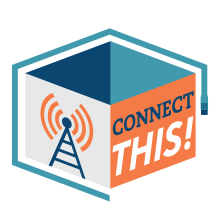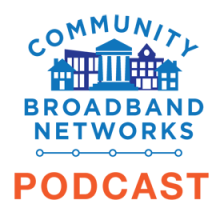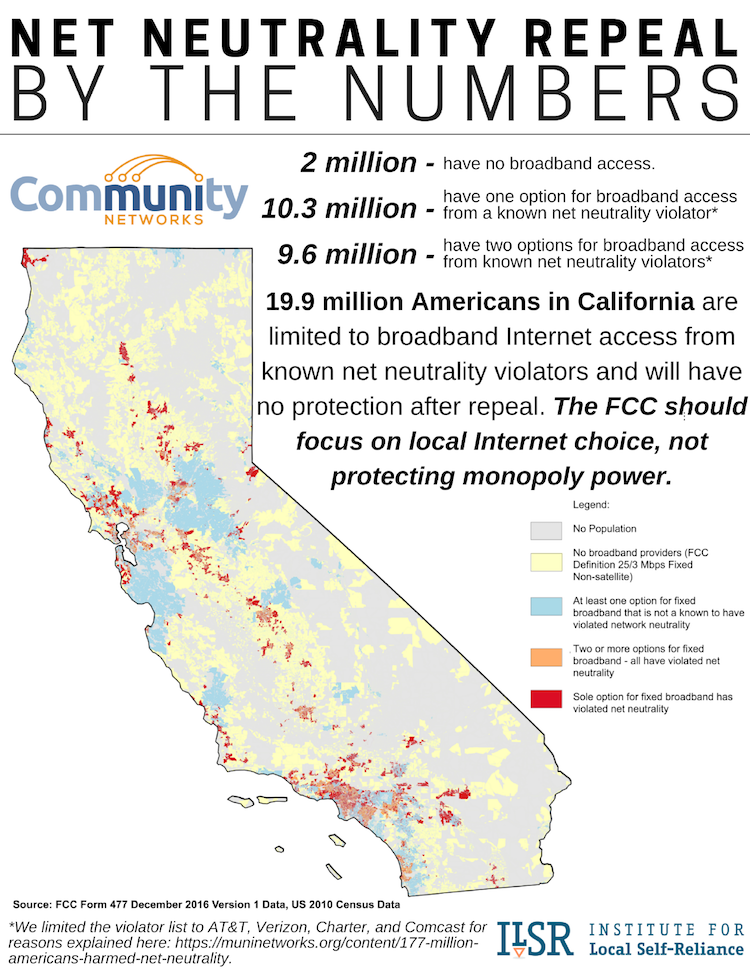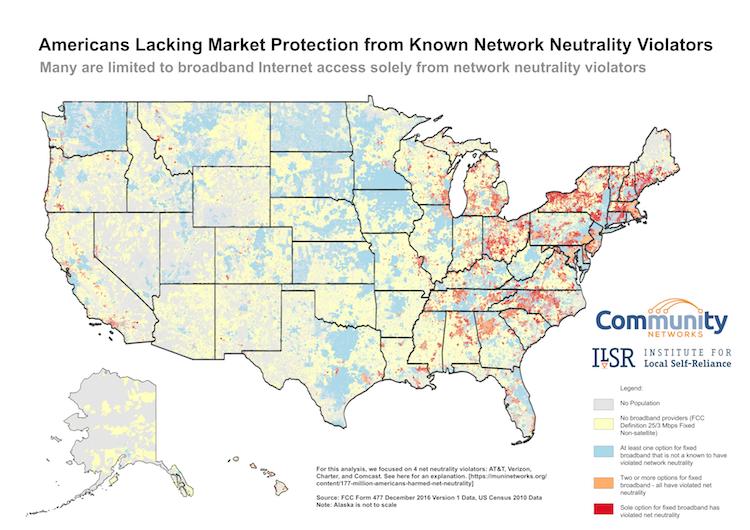
Fast, affordable Internet access for all.


Join us Friday, December 1st at 2pm ET for the latest episode of the Connect This! Show. Co-hosts Christopher Mitchell (ILSR) and Travis Carter (USI Fiber) will be joined by regular guests Doug Dawson (CCG Consulting) and Kim McKinley (UTOPIA Fiber) and special guest Mike Dano (Editorial Director, 5G & Mobile Strategies, Light Reading) to tackle the future of LTE networks - how did we get here, and where are we going? They'll talk about what happened to the 5G hype train, rural mobile wireless, market dynamics, and more. Go back and watch The Only History of LTE You'll Ever Need to catch up on part one of the discussion.
First, the crew tackles the FCC's digital discrimination proceeding in the context of ILSR Researcher Emma Gautier's recent piece on the subject. Then, they pause for a brief moment on what looks like a new dark money, anti-municipal broadband campaign aimed at UTOPIA Fiber in Utah. Finally, Christopher, Kim, Doug, and Travis are joined by Mike Dano to jump into the main subject of today's show: where we're at now, and where we expect to go, with mobile wireless networks.
Email us at broadband@communitynets.org with feedback and ideas for the show.
Subscribe to the show using this feed or find it on the Connect This! page, and watch on LinkedIn, on YouTube Live, on Facebook live, or below.

This week on the podcast, Christopher is joined by Karl Bode, a returning guest who has long covered tech and the telecommunications industry. After a short conversation about the continued absence of monopoly abuse in policy conversations about broadband access and affordability today, Karl and Christopher tackle the proposed return to net neutrality announced by Chairwoman Rosenworcel last week.
They talk about how we got here in the first place, including the landmark decision by the Commission in 2015 to largely abdicate responsibility for Internet-related regulatory activities and the states that stepped in to fill the void. They end the show by considering for a bit what it might be like to have an expert federal agency whose activities governed by a strong regulatory framework and the teeth to enforce its mandate to extend fast, affordable, reliable Internet access for all.
This show is 38 minutes long and can be played on this page or via iTunes or the tool of your choice using this feed. You can listen to the interview on this page or visit the Community Broadband Bits page.
Transcript below.
We want your feedback and suggestions for the show-please e-mail us or leave a comment below.
Listen to other episodes here or view all episodes in our index.
Subscribe to the Building Local Power podcast, also from the Institute for Local Self-Reliance, on iTunes or Stitcher to catch more great conversations about local communities, the concentration of corporate power, and how everyday people are taking control.
Thanks to Arne Huseby for the music. The song is Warm Duck Shuffle and is licensed under a Creative Commons Attribution (3.0) license.

This week on the podcast, Christopher is joined by Harold Feld, Senior Vice President at Public Knowledge. Feld is a staple of the field, and has been a consistent voice not only for consumers but broadband advocates of all types for more than two decades.
The show takes on a reflective nature, as they talk about theories of change in the context of doing broadband policy today. Harold shares how he thinks of the progress that gets made in the long term by aligning the corporate incentive with the public interest. He shares coming to terms with having lots of hard days, the power of fighting battles you expect to lose, and learning, getting better, and building powerful coalitions along the way. Harold and Christopher end the show by talking about some examples of the latter, including important wins like the Rural Tribal Priority Window and the expansion of community networks of all shapes and sizes.
This show is 48 minutes long and can be played on this page or via Apple Podcasts or the tool of your choice using this feed.
Transcript below.
We want your feedback and suggestions for the show-please e-mail us or leave a comment below.
Listen to other episodes here or view all episodes in our index. See other podcasts from the Institute for Local Self-Reliance here.
Thanks to Arne Huseby for the music. The song is Warm Duck Shuffle and is licensed under a Creative Commons Attribution (3.0) license.
Update 12/22/2017: Original maps generated on December 11th and used for these fact sheets understated the population of Americans forced to obtain services from known network neutrality violators. The problem is even greater than we originally calculated. We've update our maps and our fact sheets to reflect the more accurate data.
Network neutrality protects Americans from the ability of powerful ISPs to exercise unchecked power over what subscribers access and how quickly they receive certain content. The neutral characteristic of the Internet is one of its finest qualities. If Republican FCC Commissioners and Chairman Ajit Pai vote to shred network neutrality on December 14th as they’ve indicated, 177 million Americans will be left to the whims of a flawed market.
Mapping It Out, Presenting The Fact (Sheets)
We recently presented visualizations based on FCC Form 477 data that supports our findings on the way the repeal will limit vast swaths of people to a bleak Internet access future. Nationwide, approximately 29 million people have no broadband Internet access. Another 129 million will have no ability to change Internet access providers because there is no other option. Out of those folks, 48 million are forced to take service from an ISP that is a known network neutrality violator. Likewise, 146 million may have a choice between two ISPs, but about 52 million must choose between two network neutrality violators that have actively worked to undermine the policy for years.
Our team also parsed out the numbers for California and the East Coast from Maine to Virginia. The results are just as discouraging.
In our fact sheets, we focused on the number of people who either have no broadband access or who will be forced to take service from a firm that is a known violator of network neutrality. We've included our maps to help illustrate just how pervasive this problem is in each region.
Update 12/20/2017: Original maps generated on December 11th understated the population of Americans forced to obtain services from known network neutrality violators. The problem is even greater than we originally calculated, particularly in New York. End update.
This Thursday, December 14th, the FCC plans to remove network neutrality protections. Republican Commissioners and Chairman Ajit Pai justify the decision by claiming that the market will naturally protect subscribers from predatory big ISP behavior. Unfortunately, the FCC’s own numbers disprove their theory. We dug into the data that reveals how 177 million Americans will be left without any market protection following net neutrality repeal.
Visualizing The Data
Using FCC 477 data, we created a visualization of relevant data. This map focuses on the people and businesses at greatest risk - where they are limited to options from providers that have violated network neutrality in the past or have admitted the plans to violate it in the future.

For a larger image, download this version [18 MB png].
Download Net Neutrality Repeal By The Numbers, U.S.A. Edition, fact sheet here.
The results are not inspiring. More than 129 million people are limited to a single provider for broadband Internet access using the FCC definition of 25 Mbps download and 3 Mbps upload. Out of those 129 million Americans, about 52 million must obtain Internet access from a company that has violated network neutrality protections in the past and continues to undermine the policy today.
This is the transcript for episode 250 of the Community Broadband Bits podcast. Gary Reback, author of Free the Market: Why Only Government Can Keep the Marketplace Competitive, joins the show to discuss antitrust law. Listen to this episode here.
Christopher Mitchell: I think we have some consensus that maybe the lack of antitrust enforcement has been going on too long and we're beginning to have some problems that need to be addressed.
Lisa Gonzalez: This is episode 250 of the Community Broadband Bits Podcast. From the Institute for Local Self-Reliance, I'm Lisa Gonzalez. In this week's episode, Christoper talks with Gary Reback, attorney and author. Gary's been called the protector of the marketplace and the antitrust champion for his work representing some of Silicon Valley's best-known companies. Gary and Christopher talk about antitrust, concentration of power and the different ways shifts in antitrust enforcement negatively impact both consumers and the market as a whole. Let's get to it.
Christopher Mitchell: Welcome to another edition of the Community Broadband Bits Podcast. I'm Chris Mitchell. Today, I'm speaking with Gary Reback, a well-known Silicon Valley lawyer. Welcome to the show, Gary.
Gary Reback: Thank you.
Christopher Mitchell: I'm excited to have you on the show. You're well-known for being very involved in getting the government to sue Microsoft and for writing a book that actually came to me at a really good time about seven years ago called Free
the Market!: Why Only Government Can Keep the Marketplace Competitive. I really enjoyed that book, highly recommend it. For our audience's sake, we're not going to talk much about broadband in this conversation. But I think that many of these principles around competition in markets apply very strongly but it's something that will be sort of in the sideline. Gary, I'm curious if we can just start with a brief description of what you might describe as a working market before we spend the rest of our time talking about the markets that aren't working as well.

The larger focus of our work in the Community Broadband Networks Initiative is to ensure communities have the networks they need. Our guest for Community Broadband Bits episode 250 is an expert in how markets break and the policies that make them work.
Gary Reback is a well known Silicon Valley lawyer and Of Counsel at Carr Ferrell LLP. He also wrote an excellent book, Free the Market: Why Only Government Can Keep the Marketplace Competitive that I fully recommend. Reback has had a front-row seat to the failings of government policy that has allowed a few technology firms to garner so much market power today.
We talk broadly about markets and monopoly rather than focusing on broadband and telecommunications. This is a good introductory conversation for people unfamiliar with the real threat and harms of monopoly.
A related conversation is my interview with Barry Lynn in episode 83.
This show is 25 minutes long and can be played on this page or via Apple Podcasts or the tool of your choice using this feed.
Transcript below.
We want your feedback and suggestions for the show-please e-mail us or leave a comment below.
Listen to other episodes here or view all episodes in our index. See other podcasts from the Institute for Local Self-Reliance here.
Thanks to Arne Huseby for the music. The song is Warm Duck Shuffle and is licensed under a Creative Commons Attribution (3.0) license.
“Monopoly” may be a fun family night activity, but if you live in a place where you have little or no choice for Internet access, it’s not fun and it’s not a game.
According to FCC data, most families don’t have a choice in Internet access providers, especially providers they like. Nevertheless, the biggest companies keep reporting increasing revenues every year. People aren’t happy with the service they’re receiving, but companies like AT&T and Comcast continue to thrive. What’s going on?
In a recent State Scoop piece, Christopher wrote:
[T]he market is not providing a check to AT&T or Comcast power. They are effectively monopolies — and as we just saw — can translate their market power into political power to wipe out regulations they find annoying.
At the Institute for Local Self-Reliance, where we work to support local economies, this broken market is a major problem. Cable monopolies are bad for local businesses, which become less competitive from paying too much for unreliable Internet access. Communities cannot thrive without high quality Internet access today.
We created this infographic to present the evidence showing that the market is broken. This resource also discusses why creating more competition in the current market is such a challenge. An effective way to overcome this broken market, however, is to consider what hundreds of local communities are already doing - investing in publicly owned Internet infrastructure. Our infographic offers a few examples of different models, each chosen to suit the communities they serve.
Get a larger version of the infographic here.

Get a larger version of the infographic here.
Kudos to intern Kate Svitavsky who created the infographic.
Stay up to date on community networks with our newsletter.
Back in 2010, we reported on the merger between Comcast and NBC, which was in the works at the time. One of the issues that came up was how programming is chosen.
At the time, the Tennis Channel had filed a suit against Comcast, alleging that Comcast did not make Tennis Channel programming available to as many subscribers as the Golf Channel and NBC Sports (both belong to Comcast). Comcast, under the Communications Act and Commission rules, is required to place channels owned by others on tiers equal to its own similar types of channels and can't play favorites.
The FCC had reviewed the case at various levels for two years (there was an appeal) and finally, in July of this year, issued a decision in favor of the Tennis Channel. The Tennis Channel alleged discrimination, Comcast argued the Tennis Channel was using the FCC to get out of a contract it wanted to escape. According to a Meg James LA Times article:
The FCC ordered Comcast to provide the Tennis Channel with distribution comparable to the two sports channels, which would effectively increase its coverage by about 18 million homes, and force Comcast to pay Tennis Channel millions of dollars more each year in programming fees.
It was the first time that a major cable operator has been found in violation of federal anti-discrimination program carriage rules that were established in 1993.
Comcast was ordered to remedy the situation within 45 days, a window that would make the Tennis Channel available in more homes during one of the biggest tennis events of the year, the U.S. Open in New York. The channel is currently available in about 34 million homes nationally.
Comcast immediately asked for a stay from the remedy, appealing to the U.S. Court of Appeals for the D.C. Circuit. Comcast was granted the stay while the case is argued on appeal. Once again, Comcast's army of lawyers are strategically using the court as a way to slow down an adversary's remedy.